Kaixuan Wei
Large-Area Fabrication-aware Computational Diffractive Optics
May 28, 2025Abstract:Differentiable optics, as an emerging paradigm that jointly optimizes optics and (optional) image processing algorithms, has made innovative optical designs possible across a broad range of applications. Many of these systems utilize diffractive optical components (DOEs) for holography, PSF engineering, or wavefront shaping. Existing approaches have, however, mostly remained limited to laboratory prototypes, owing to a large quality gap between simulation and manufactured devices. We aim at lifting the fundamental technical barriers to the practical use of learned diffractive optical systems. To this end, we propose a fabrication-aware design pipeline for diffractive optics fabricated by direct-write grayscale lithography followed by nano-imprinting replication, which is directly suited for inexpensive mass production of large area designs. We propose a super-resolved neural lithography model that can accurately predict the 3D geometry generated by the fabrication process. This model can be seamlessly integrated into existing differentiable optics frameworks, enabling fabrication-aware, end-to-end optimization of computational optical systems. To tackle the computational challenges, we also devise tensor-parallel compute framework centered on distributing large-scale FFT computation across many GPUs. As such, we demonstrate large scale diffractive optics designs up to 32.16 mm $\times$ 21.44 mm, simulated on grids of up to 128,640 by 85,760 feature points. We find adequate agreement between simulation and fabricated prototypes for applications such as holography and PSF engineering. We also achieve high image quality from an imaging system comprised only of a single DOE, with images processed only by a Wiener filter utilizing the simulation PSF. We believe our findings lift the fabrication limitations for real-world applications of diffractive optics and differentiable optical design.
Single-shot Phase Retrieval from a Fractional Fourier Transform Perspective
Nov 18, 2023



Abstract:The realm of classical phase retrieval concerns itself with the arduous task of recovering a signal from its Fourier magnitude measurements, which are fraught with inherent ambiguities. A single-exposure intensity measurement is commonly deemed insufficient for the reconstruction of the primal signal, given that the absent phase component is imperative for the inverse transformation. In this work, we present a novel single-shot phase retrieval paradigm from a fractional Fourier transform (FrFT) perspective, which involves integrating the FrFT-based physical measurement model within a self-supervised reconstruction scheme. Specifically, the proposed FrFT-based measurement model addresses the aliasing artifacts problem in the numerical calculation of Fresnel diffraction, featuring adaptability to both short-distance and long-distance propagation scenarios. Moreover, the intensity measurement in the FrFT domain proves highly effective in alleviating the ambiguities of phase retrieval and relaxing the previous conditions on oversampled or multiple measurements in the Fourier domain. Furthermore, the proposed self-supervised reconstruction approach harnesses the fast discrete algorithm of FrFT alongside untrained neural network priors, thereby attaining preeminent results. Through numerical simulations, we demonstrate that both amplitude and phase objects can be effectively retrieved from a single-shot intensity measurement using the proposed approach and provide a promising technique for support-free coherent diffraction imaging.
Spatially Varying Nanophotonic Neural Networks
Aug 07, 2023



Abstract:The explosive growth of computation and energy cost of artificial intelligence has spurred strong interests in new computing modalities as potential alternatives to conventional electronic processors. Photonic processors that execute operations using photons instead of electrons, have promised to enable optical neural networks with ultra-low latency and power consumption. However, existing optical neural networks, limited by the underlying network designs, have achieved image recognition accuracy much lower than state-of-the-art electronic neural networks. In this work, we close this gap by introducing a large-kernel spatially-varying convolutional neural network learned via low-dimensional reparameterization techniques. We experimentally instantiate the network with a flat meta-optical system that encompasses an array of nanophotonic structures designed to induce angle-dependent responses. Combined with an extremely lightweight electronic backend with approximately 2K parameters we demonstrate a nanophotonic neural network reaches 73.80\% blind test classification accuracy on CIFAR-10 dataset, and, as such, the first time, an optical neural network outperforms the first modern digital neural network -- AlexNet (72.64\%) with 57M parameters, bringing optical neural network into modern deep learning era.
Instance Segmentation in the Dark
Apr 27, 2023Abstract:Existing instance segmentation techniques are primarily tailored for high-visibility inputs, but their performance significantly deteriorates in extremely low-light environments. In this work, we take a deep look at instance segmentation in the dark and introduce several techniques that substantially boost the low-light inference accuracy. The proposed method is motivated by the observation that noise in low-light images introduces high-frequency disturbances to the feature maps of neural networks, thereby significantly degrading performance. To suppress this ``feature noise", we propose a novel learning method that relies on an adaptive weighted downsampling layer, a smooth-oriented convolutional block, and disturbance suppression learning. These components effectively reduce feature noise during downsampling and convolution operations, enabling the model to learn disturbance-invariant features. Furthermore, we discover that high-bit-depth RAW images can better preserve richer scene information in low-light conditions compared to typical camera sRGB outputs, thus supporting the use of RAW-input algorithms. Our analysis indicates that high bit-depth can be critical for low-light instance segmentation. To mitigate the scarcity of annotated RAW datasets, we leverage a low-light RAW synthetic pipeline to generate realistic low-light data. In addition, to facilitate further research in this direction, we capture a real-world low-light instance segmentation dataset comprising over two thousand paired low/normal-light images with instance-level pixel-wise annotations. Remarkably, without any image preprocessing, we achieve satisfactory performance on instance segmentation in very low light (4~\% AP higher than state-of-the-art competitors), meanwhile opening new opportunities for future research.
Deep Plug-and-Play Prior for Hyperspectral Image Restoration
Sep 17, 2022
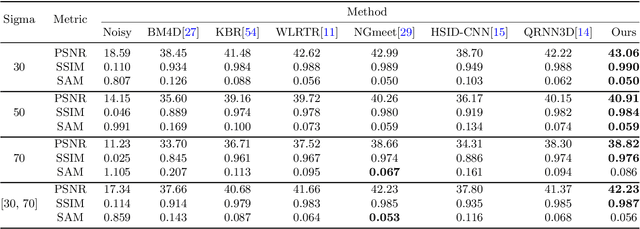


Abstract:Deep-learning-based hyperspectral image (HSI) restoration methods have gained great popularity for their remarkable performance but often demand expensive network retraining whenever the specifics of task changes. In this paper, we propose to restore HSIs in a unified approach with an effective plug-and-play method, which can jointly retain the flexibility of optimization-based methods and utilize the powerful representation capability of deep neural networks. Specifically, we first develop a new deep HSI denoiser leveraging gated recurrent convolution units, short- and long-term skip connections, and an augmented noise level map to better exploit the abundant spatio-spectral information within HSIs. It, therefore, leads to the state-of-the-art performance on HSI denoising under both Gaussian and complex noise settings. Then, the proposed denoiser is inserted into the plug-and-play framework as a powerful implicit HSI prior to tackle various HSI restoration tasks. Through extensive experiments on HSI super-resolution, compressed sensing, and inpainting, we demonstrate that our approach often achieves superior performance, which is competitive with or even better than the state-of-the-art on each task, via a single model without any task-specific training.
* code at https://github.com/Zeqiang-Lai/DPHSIR
Physics-based Noise Modeling for Extreme Low-light Photography
Aug 04, 2021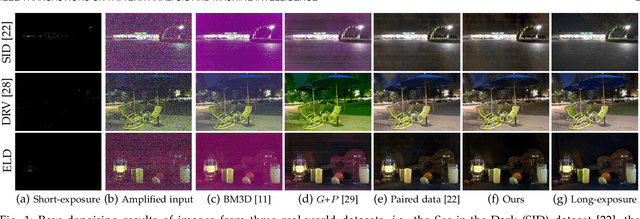
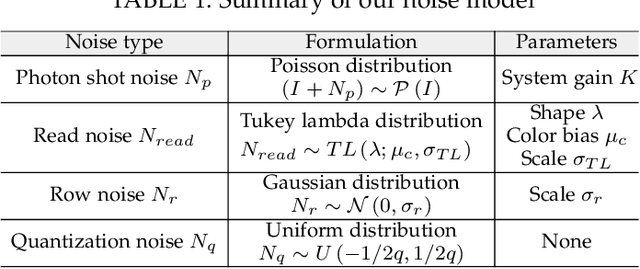
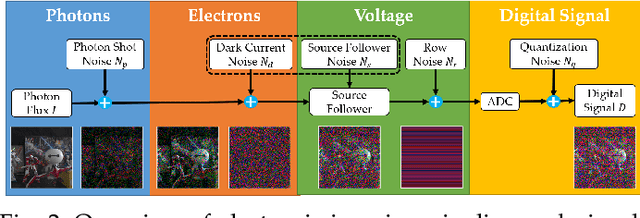
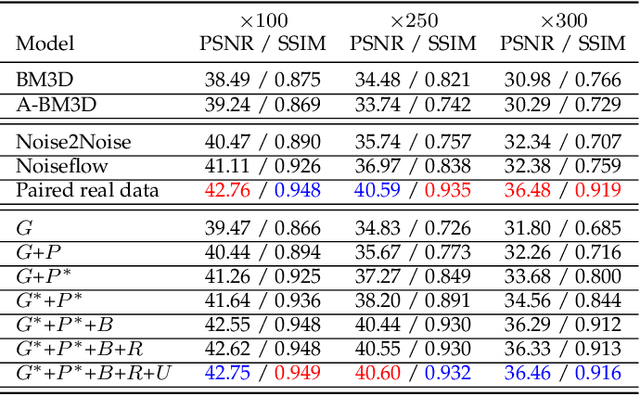
Abstract:Enhancing the visibility in extreme low-light environments is a challenging task. Under nearly lightless condition, existing image denoising methods could easily break down due to significantly low SNR. In this paper, we systematically study the noise statistics in the imaging pipeline of CMOS photosensors, and formulate a comprehensive noise model that can accurately characterize the real noise structures. Our novel model considers the noise sources caused by digital camera electronics which are largely overlooked by existing methods yet have significant influence on raw measurement in the dark. It provides a way to decouple the intricate noise structure into different statistical distributions with physical interpretations. Moreover, our noise model can be used to synthesize realistic training data for learning-based low-light denoising algorithms. In this regard, although promising results have been shown recently with deep convolutional neural networks, the success heavily depends on abundant noisy clean image pairs for training, which are tremendously difficult to obtain in practice. Generalizing their trained models to images from new devices is also problematic. Extensive experiments on multiple low-light denoising datasets -- including a newly collected one in this work covering various devices -- show that a deep neural network trained with our proposed noise formation model can reach surprisingly-high accuracy. The results are on par with or sometimes even outperform training with paired real data, opening a new door to real-world extreme low-light photography.
Dynamic Proximal Unrolling Network for Compressive Sensing Imaging
Jul 23, 2021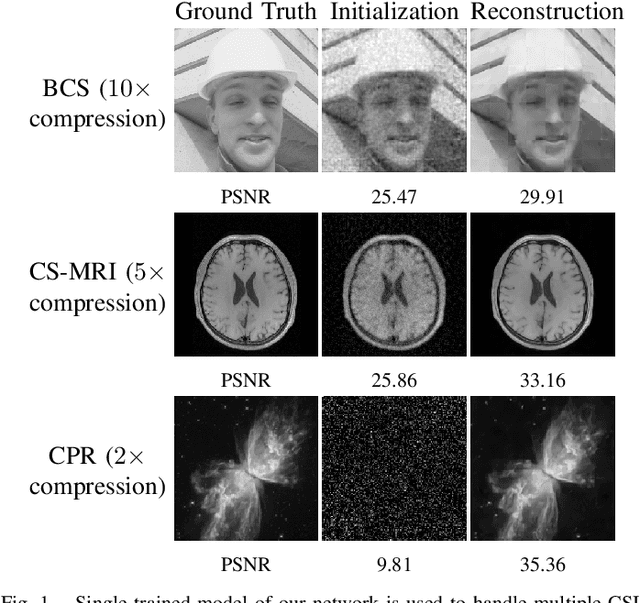
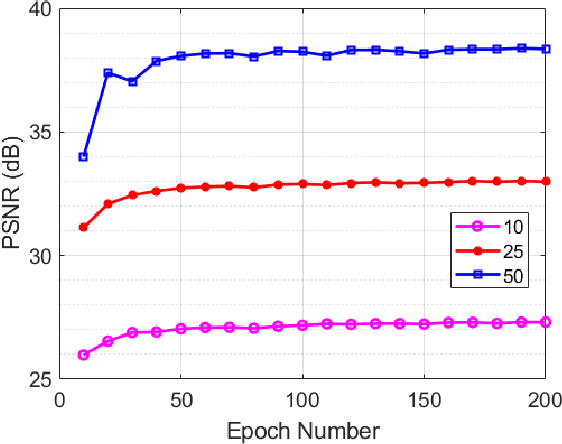
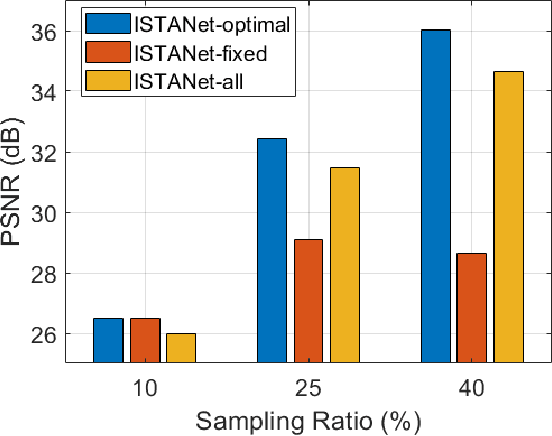

Abstract:Recovering an underlying image from under-sampled measurements, Compressive Sensing Imaging (CSI) is a challenging problem and has many practical applications. Recently, deep neural networks have been applied to this problem with promising results, owing to its implicitly learned prior to alleviate the ill-poseness of CSI. However, existing neural network approaches require separate models for each imaging parameter like sampling ratios, leading to training difficulties and overfitting to specific settings. In this paper, we present a dynamic proximal unrolling network (dubbed DPUNet), which can handle a variety of measurement matrices via one single model without retraining. Specifically, DPUNet can exploit both embedded physical model via gradient descent and imposing image prior with learned dynamic proximal mapping leading to joint reconstruction. A key component of DPUNet is a dynamic proximal mapping module, whose parameters can be dynamically adjusted at inference stage and make it adapt to any given imaging setting. Experimental results demonstrate that the proposed DPUNet can effectively handle multiple CSI modalities under varying sampling ratios and noise levels with only one model, and outperform the state-of-the-art approaches.
TFPnP: Tuning-free Plug-and-Play Proximal Algorithm with Applications to Inverse Imaging Problems
Dec 11, 2020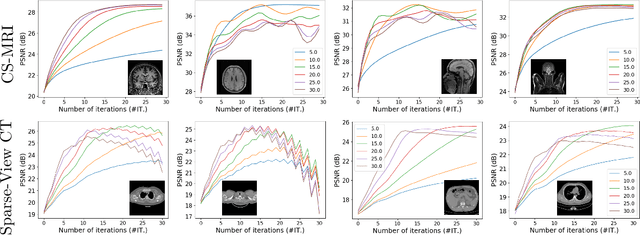
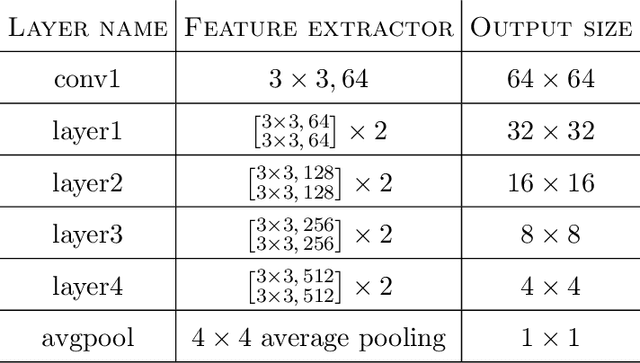


Abstract:Plug-and-Play (PnP) is a non-convex framework that combines proximal algorithms, for example alternating direction method of multipliers (ADMM), with advanced denoiser priors. Over the past few years, great empirical success has been obtained by PnP algorithms, especially for the ones integrated with deep learning-based denoisers. However, a crucial issue of PnP approaches is the need of manual parameter tweaking. As it is essential to obtain high-quality results across the high discrepancy in terms of imaging conditions and varying scene content. In this work, we present a tuning-free PnP proximal algorithm, which can automatically determine the internal parameters including the penalty parameter, the denoising strength and the termination time. A core part of our approach is to develop a policy network for automatic search of parameters, which can be effectively learned via mixed model-free and model-based deep reinforcement learning. We demonstrate, through a set of numerical and visual experiments, that the learned policy can customize different parameters for different states, and often more efficient and effective than existing handcrafted criteria. Moreover, we discuss the practical considerations of the plugged denoisers, which together with our learned policy yield to state-of-the-art results. This is prevalent on both linear and nonlinear exemplary inverse imaging problems, and in particular, we show promising results on compressed sensing MRI, sparse-view CT and phase retrieval.
A Physics-based Noise Formation Model for Extreme Low-light Raw Denoising
Apr 09, 2020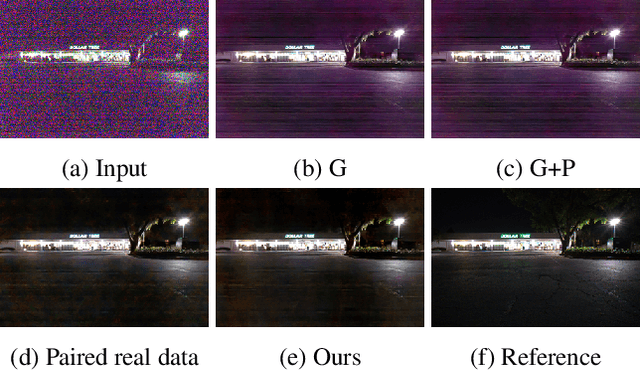
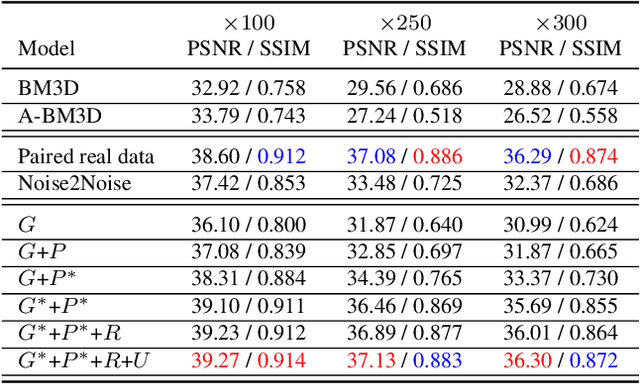

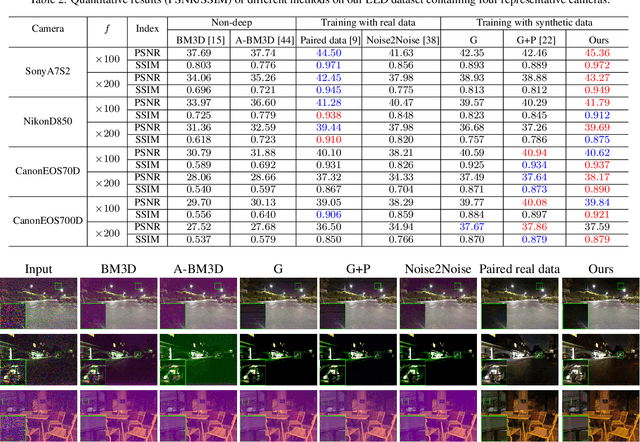
Abstract:Lacking rich and realistic data, learned single image denoising algorithms generalize poorly to real raw images that do not resemble the data used for training. Although the problem can be alleviated by the heteroscedastic Gaussian model for noise synthesis, the noise sources caused by digital camera electronics are still largely overlooked, despite their significant effect on raw measurement, especially under extremely low-light condition. To address this issue, we present a highly accurate noise formation model based on the characteristics of CMOS photosensors, thereby enabling us to synthesize realistic samples that better match the physics of image formation process. Given the proposed noise model, we additionally propose a method to calibrate the noise parameters for available modern digital cameras, which is simple and reproducible for any new device. We systematically study the generalizability of a neural network trained with existing schemes, by introducing a new low-light denoising dataset that covers many modern digital cameras from diverse brands. Extensive empirical results collectively show that by utilizing our proposed noise formation model, a network can reach the capability as if it had been trained with rich real data, which demonstrates the effectiveness of our noise formation model.
3D Quasi-Recurrent Neural Network for Hyperspectral Image Denoising
Mar 10, 2020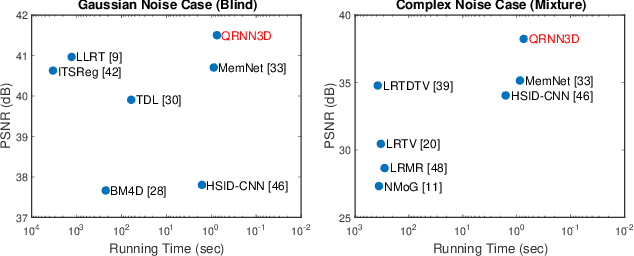
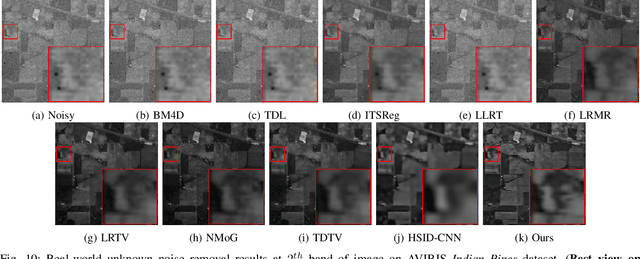
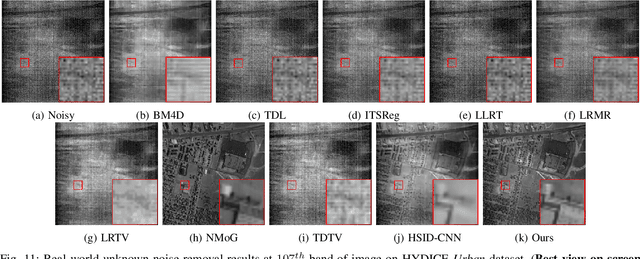
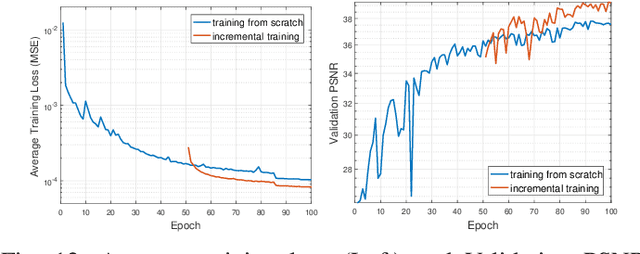
Abstract:In this paper, we propose an alternating directional 3D quasi-recurrent neural network for hyperspectral image (HSI) denoising, which can effectively embed the domain knowledge -- structural spatio-spectral correlation and global correlation along spectrum. Specifically, 3D convolution is utilized to extract structural spatio-spectral correlation in an HSI, while a quasi-recurrent pooling function is employed to capture the global correlation along spectrum. Moreover, alternating directional structure is introduced to eliminate the causal dependency with no additional computation cost. The proposed model is capable of modeling spatio-spectral dependency while preserving the flexibility towards HSIs with arbitrary number of bands. Extensive experiments on HSI denoising demonstrate significant improvement over state-of-the-arts under various noise settings, in terms of both restoration accuracy and computation time. Our code is available at https://github.com/Vandermode/QRNN3D.
 Add to Chrome
Add to Chrome Add to Firefox
Add to Firefox Add to Edge
Add to Edge